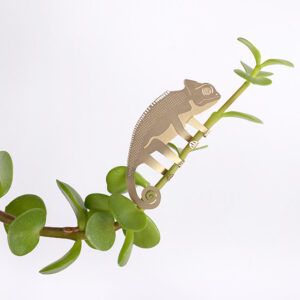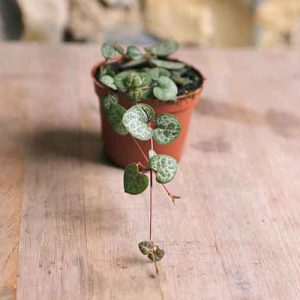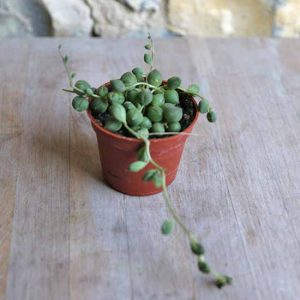HOW TO CARE FOR YOUR CEROPEGIA WOODII (STRING OF HEARTS PLANT)
THE STRING OF HEARTS PLANT
Ceropegia Woodii AKA. Snakecreeper / Entangled Hearts / Lantern Flower / Parasol Flower / Rosary Vine
As the name suggests, the Ceropegia Woodii is beyond cute. This trailing vine’s delicate, mixed-green leaves are shaped like hearts and are perfect for adding a decorative touch to your home in a hanging basket. This species was first written about in Europe by Swedish botanist Carl Linnaeus in the first volume of his meaty, Latin tome: Species Plantarum which was published in 1753. He thought the foliage resembled a fountain of wax (huh?) from which we get the Latin name for the species, derived from the Greco-Roman ‘ceros’ (wax)… I think we’ll stick with String of Hearts…

Where Does It Come From?
Native to southern Africa, Asia and Australia, this plant is relatively abundant in roasty-toasty climates. There are more than 180 varieties of the ceropegia genus and more are discovered every few years in remote patches of tropical forest in hard-to-reach areas of subsaharan Africa and remote islands such as Madagascar.
Why Should I Get One?
- Despite being vulnerable to certain pests like aphids, overall the String of Hearts is a fairly resilient plant that requires relatively little care. Moderate watering, a cosy, partially shaded spot and the odd feed is enough for this attractive little evergreen to flourish in the home.
- Regular pruning is also virtually unnecessary, so once you’ve gotten this plant settled in, it is quite low maintenance. However, if it does get too long, just chop it! It will happily tolerate haircuts with no issues.
- Non-toxic to cats and dogs (which is particularly good news for cats who love to play with the trailing leaves)
How Big Can It Grow?
What size your String of Hearts ultimately reaches tends to depend on how close to the optimum conditions you can get for the plant in your own home. Unconfined, these trailing or climbing vines can expand quite a lot and in a houseplant setting can still reach up to 2 metres of vine, occasionally more. Normally, the plants reach their ultimate size after two to five years of growth.
Where Should I Keep It?
The String of Hearts is a shy member of your houseplant family and likes to be tucked away in sheltered positions where it enjoys partial shade. A west or east-facing aspect works well as long as the plant isn’t going to get roasted by direct sunshine. Again, as a vine, the plant is used to being sheltered from the sunshine by the larger plants it uses for support, so be sure to bear this in mind when finding the perfect spot for your new plant-baby.
Pro Tip: This one produces such lovely cascades of its fleshy leaves if suspended in a hanging basket. This is a brilliant way to bring a bit of greenery into a room to brighten things up without sacrificing floor or shelving space.
How Often Should I Water It?
Neutral soil suited to cacti works quite nicely for the String of Hearts. Sandy or loam-based earth with plenty of drainage is best and I recommend watering the plant moderately during major growth periods like the summertime. Be careful not to over-water this one, as the plant has been known to be a victim of root-rot when it gets too soggy. A low-nitrogen liquid fertiliser is an added bonus, but is only necessary perhaps once per month.
Bringing a touch of the sweltering jungles of Africa and Asia to your living room, a little goes a long way with the String of Hearts. With a little care here and there, as long as you avid loving it to death, this pretty evergreen can brighten up your indoor spaces for years to come.




